Dispositifs de contrôle des émissions de véhicules diesel
Policy Implementation Period
Except for the days when yellow-dust storms occur, the annual PM10 concentration in Seoul has shown a decreasing trend since 2003, and as of 2014, the fine-dust concentration is 44 ㎍/㎥. Fine dust shows a seasonal pattern. The fine-dust concentration is highest in spring due to the yellow dust, followed by winter, with the highly stagnant atmosphere frequency caused by heating and radiative cooling. Its concentration is lowest in summer, with high amounts of rainfall. In addition, fine dust has seasonal characteristics; its concentration is highest in spring, when yellow-dust storms frequently occur.
To prevent environmental damages due to fine dust, protect the health of the citizens, and create a comfortable environment, the government has established air quality standards and has ensured the adequate maintenance of the air quality in Seoul despite the changes in the environmental conditions. In 1993, fine dust (PM10) was included in the national air quality standards.
In addition, with the revision of the Environmental Policy Framework Act on December 4, 2006, an enhanced standard compared to the existing environmental standards has been applied from January 1, 2007, and ultra-fine dust (PM2.5), a new item, was added and has been applied from 2015.
Table 1. National and Seoul Air Quality Standards
| Item | National standard | Seoul standard | Measuring method |
| Sulfur dioxide (SO2) | 0.02ppm/year 0.05ppm/day 0.15ppm/hour |
0.01ppm/year 0.04ppm/day 0.12ppm/hour |
Ultraviolet fluorescence method |
| Fine dust (PM10) | 50㎍/m3/year 100㎍/m3/day |
50㎍/m3/year 100㎍/m3/day |
Beta absorption method |
| Fine dust (PM2.5) | 25㎍/m3/year 50㎍/m3/day |
25㎍/m3/year 50㎍/m3/day |
Weight concentration method or equivalent automatic measuring method |
| Nitrogen dioxide (NO2) | 0.03ppm/year 0.06ppm/day 0.10ppm/hour |
0.03ppm/year 0.06ppm/day 0.10ppm/hour |
Chemical luminescence method |
| Ozone (O3) | 0.06ppm/8hr 0.1ppm/hr |
0.06ppm/8hr 0.1ppm/hr |
UV photometric method |
| Carbon monoxide (CO) | 9ppm/8hr 25ppm/hr |
9ppm/8hr 25ppm/hr |
Non-dispersive infrared analysis method |
| Lead (Pb) | 0.5㎍/m3/year | 0.5㎍/m3/year | Atomic absorption spectroscopy |
| Benzene (C6H6) | 5㎍/m3/year | 5㎍/m3/year | Gas chromatography |
In 2003, 『Special Act on Seoul Metropolitan Air Quality Improvement』 was established to improve the air quality in the capital area, where Seoul, Incheon, and Gyeonggi provinces are located, and based on this, 『Seoul Metropolitan Air Quality Control Master Plan』 established in 2005 has set the target air quality improvement levels of PM10 40 ㎍/m3, NO2 22 ppb by 2014.
The detailed promotion plans of 『Seoul Metropolitan Air Quality Control Master Plan 』 include the automobile management, including production and operation of cars and traffic demand management; the total load management for large establishment ; the small and pollution source management for small-and-midium sized enterprises and towns; and the eco-friendly energy and urban management projects.
The 2nd Seoul Metropolitan Air Quality Control Master Plan was established and announced in December 2013. The 2nd Special Measures for the Seoul Metropolitan Air Quality Improvement with the target period 2015-2024 switched the policy direction from target concentration management to risk to human health. According to the regulations on 『Special Act on Seoul Metropolitan Air Quality Improvement』, Seoul’s action plan for the 2nd Seoul Metropolitan Air Quality Management was established in 2014 to promote the 2nd Seoul Metropolitan Air Quality Control Master Plan , and detailed plans for the reduction of air pollutants by pollution source have been implemented to ensure eco-friendly traffic demand control through the attachment of diesel particulate filters (DPFs) to diesel vehicles for low pollution, post-management, strengthening of the allowable-emission criteria, spread of low-pollution vehicles, exhaust gas management, dissemination of the weekly no-driving day program, and review of the restrictions on driving diesel vehicles in case of failure to comply with such low-pollution measures. To reduce the pollutants discharged from businesses, the total pollutant control systems allocate yearly total allowable emissions and manage the emissions within the range of the allocated amount for large businesses. In the case of small and mid-sized businesses, promotion measures like the spread of eco-friendly energy and the expansion of the clean-energy supply have been implemented by strengthening the allowable-emission standards.
The Seoul metropolitan government selected the 20% reduction of ultra-fine dust in 2015 as an important policy project, and has strived to reduce the existing annual PM2.5 pollution level of 25 ㎍/㎥ to 20 ㎍/㎥.
Background Information
With respect to the atmospheric environment of the capital area, the concentration of fine dust, which causes lung cancer and premature death, reaches twice that of Tokyo. The social costs due to air pollution amounts to an annual 12 trillion won, and the number of annual premature deaths caused by fine dust is estimated to reach 20,000 in 2024. As fine dust, which, as said earlier, is harmful to the human body, is mainly generated from diesel vehicles, measures to reduce the fine-dust levels in the air in Seoul targeting diesel vehicles are needed, and therefore, fine-dust reduction measures targeting diesel vehicles have been promoted in the air quality management areas such as Seoul, Gyeonggi, and Incheon, based on the Special Act on Seoul Metropolitan Air Quality Improvement.
According to OECD in 2002, the level of fine-dust (PM10) pollution in Seoul was the worst among the large cities of the OECD countries. To host the 2002 World Cup events in a more pleasant environment, the South Korean government actively promoted policies and researches on the spread of no- or low-pollution vehicles. The Seoul metropolitan government proceeded with projects involving replacing diesel buses with CNG buses and turning mid-sized and large old diesel vehicles into low-pollution ones. The project of attaching an emission reduction device to diesel vehicles is included in the project of turning old diesel vehicles into low-pollution ones.
Meanwhile, Seoul’s PM10 and NO2 concentrations in 2003 were 69 ㎍/m3 and 38 ppb, respectively, 1.9-3.6 and 1.4-1.9 times those of the major OECD cities. The social cost of the capital area due to the damages caused by such air pollution was estimated at 10 trillion won in 2000, and the number of deaths in Seoul caused by fine dust was estimated to have been 1,940 in the same year. To reduce the high fine-dust concentration in the city’s air, the Seoul metropolitan government established the Seoul Metropolitan Air Quality Control Master Plan, which includes various improvement measures, among them the introduction of Total Industrial Site Volume Control System(TISVCS) by the end of 2003, the spread of low-pollution vehicles, and the management of exhaust gas from vehicle.
Some years before 1995, the number of registered vehicles in Seoul showed a more than 10% rising trend annually due to the rapid industrialization and income increase, but the growth rate slowed down from 1995. The total number of vehicles in South Korea in 1965 was only about 40,000, but the number went beyond 10 million in 1997, increasing more than 250 times in 30 years. As of 2014, the total number of vehicles in the city is 201.2 million, and the air pollution problem caused by exhaust gases is becoming increasingly serious. In particular, 8.96 million vehicles, about 44.5% of the total number of vehicles in South Korea, are concentrated in the capital area (Seoul・Gyeeonggi・Incheon). Particularly, 15% of the vehicles are concentrated in Seoul, which also has a very high population density. Thus, air pollution caused by vehicle pollutants has become a very important issue in large cities.
Table SEQ 표
\* ARABIC2. Increase in the number of vehicles in the entire country and in Seoul
|
(Unit: 1,000) |
||||||||||||
|
|
1975 |
1980 |
1985 |
1990 |
1995 |
2000 |
2003 |
2006 |
2009 |
2012 |
2013 |
2014 |
|
Entire country |
201 |
528 |
1,113 |
3,395 |
8,469 |
12,060 |
14,587 |
15,895 |
17,325 |
18,871 |
19,401 |
20,118 |
|
Seoul |
85 |
207 |
446 |
1,194 |
2,043 |
2,441 |
2,777 |
2,857 |
2,955 |
2,969 |
2,974 |
3,014 |
At the end of 2014, the diesel vehicles in Seoul accounted for 33.1% of all the vehicles in the city, relatively higher than in other countries. The reason for this was that diesel oil is cheaper than gasoline oil due to the country’s industrial and energy policy, and the fuel efficiency of diesel vehicles is slightly superior. In other countries, such as the United States, Japan, and Germany, the diesel vehicles account for only 3, 13, and 18% of all the vehicles, respectively. With the improvement of the engine and emission control technologies, however, the supply of diesel vehicles has increased due to their economic benefits.
Table SEQ 표
\* ARABIC3. Number of registered vehicles by type
|
(Unit: 1,000) |
|||||||||||
|
Division |
1994 |
1996 |
1998 |
2000 |
2004 |
2006 |
2009 |
2010 |
2012 |
2013 |
2014 |
|
Total |
1,932 |
2,168 |
2,199 |
2,441 |
2,780 |
2,857 |
2,954 |
2,981 |
2,969 |
2,974 |
3,014 |
|
Diesel vehicles |
433 |
473 |
471 |
542 |
797 |
848 |
854 |
863 |
899 |
937 |
997 |
|
Gasoline/gas vehicles |
1,499 |
1,695 |
1,728 |
1,899 |
1,983 |
2,009 |
2,100 |
2,118 |
2,070 |
2,037 |
2,017 |
In 2011, the air pollution emissions from vehicles totaled 135,637 tons, which accounted for 52% of the total emissions, and 81% of the CO emissions, 45% of the nitrogen oxide (NOx) emissions, and 49% of the fine-dust emissions are generated from vehicles.
Figure 1. Pollutant emissions from vehicles

『The 1st Special Measures for Seoul Metropolitan Air Quality』seeks to secure the degree of visibility of the open sea of Incheon from Namsan on a clear day. Towards this end, an about 4 trillion won budget from both the national treasury and the local funds had been used for 10 years (2005-2014). Ninety percent of the total budget was allotted for the old-diesel-vehicle exhaust gas reduction project, and an action plan was formulated and implemented to turn old diesel vehicles into low-pollution ones. The improvement target was set to 40㎍/m3 PM10 (Tokyo) and 22ppb NO2 (Paris).
『The 2nd Special Measures for Seoul Metropolitan Air Quality』 seeks to realize a healthy 100-year-old era with clean air, and efforts were set to be made to achieve the goal from 2015 to 2024. The improvement targets were set to 20㎍/m3 PM2.5, 30㎍/m3 PM10, 21ppb NO2, and 60ppb O2, and the focus was expanded to include gasoline and gas cars, in addition to diesel vehicles.
In the case of specific diesel vehicles, cars whose emission warranty period has expired in accordance with Article 46 of 『Clean Air Conservation Act』; light cars and passenger cars whose emission warranty period has expired in accordance with No. 3, Annexed Table 5 of 『Enforcement Regulations of Clean Air Conservation Act』; and vehicles whose emission warranty period has expired in accordance with No. 5, Title 4 are excluded from the implementation of 『Clean Air Conservation Act』, as shown below.
Table SEQ 표
\* ARABIC4. Enforcement Regulations of the Clean Air Conservation Act
|
Specific diesel vehicles |
Specific diesel vehicles (excluding some vehicles) |
Excluded vehicles |
||
|
No.1 Until December 31, 2000 |
No.2 January 1, 2000- June 30, 2002 |
No.3 On and after July 1, 2002 |
No. 4 On and after January 1, 2006 |
No.5 On and after January 1, 2009 |
|
All diesel vehicles |
All diesel vehicles |
<Exclusions> - Light cars (less than 800cc) - Passenger cars weighing less than 2.5 tons and with less than 8 passengers |
All diesel vehicles |
All diesel vehicles |
Annex Table 18 of the Enforcement Regulations of the Clean Air Conservation Act regulates the exhaust gas application period depending on the production period of the diesel vehicles.
Table 5. Enforcement Regulations of the Clean Air Conservation Act
|
Production period |
Application period |
Vehicle type |
||||
|
On and before December 31, 1997 |
|
Passenger car |
Small truck |
|
|
|
|
February 2, 1991-December 31, 1992 |
|
|
|
|
|
|
|
January 1, 1993-December 31, 1995 |
5 years, 80,000㎞ |
|
|
|
|
|
|
January 1, 1996-December 31, 1997 |
5 years, 80,000㎞ |
40,000㎞ |
|
|
|
|
|
January 1, 1998-December 31, 2000 |
|
Light car |
Passenger car |
Small truck |
Heavy-duty vehicle |
|
|
January 1, 1998-December 31, 1999 |
60,000㎞ |
5 years, 80,000㎞ |
60,000㎞ |
- |
|
|
|
January 1, 2000-December 31, 2000 |
5 years, 80,000㎞ |
5 years, 80,000㎞ |
5 years, 80,000㎞ |
2 years, 40,000㎞ |
|
|
|
January 1, 2001-June 30, 2002 |
|
Light car |
Passenger car |
Multi-purpose car |
Mid-sized car |
Large car |
|
January 1, 2001-June 30, 2002 |
5 years, 80,000㎞ |
5 years, 80,000㎞ |
5 years, 80,000㎞ |
5 years, 80,000㎞ |
2 years, 80,000㎞ |
|
|
July 1, 2002-December 31, 2005 |
|
Light car |
Passenger car 1/ passenger car 2 |
Passenger car 3/ truck 1/ truck 2 |
Passenger car 4/ truck 3 |
Construction machinery |
|
July 1, 2002-December 31, 2002 |
5 years, 80,000㎞ |
5 years, 80,000㎞ |
5 years, 80,000㎞ |
2 years, 80,000㎞ |
|
|
|
After January 1, 2003 |
5 years, 80,000㎞ |
5 years, 80,000㎞ |
5 years, 80,000㎞ |
2 years, 160,000㎞ |
1 year, 20,000㎞ |
|
|
January 1, 2006-December 31, 2008 |
|
Light car |
Small passenger car |
Small truck/mid-sized passenger car/truck |
Large/ ultra-large passenger car/truck |
Construction machinery |
|
|
5 years, 80,000㎞ |
5 years, 80,000㎞ |
5 years, 80,000㎞ |
2 years, 160,000㎞ |
1 year, 20,000㎞ |
|
|
On and after January 1, 2009 |
|
Light/small/mid-sized passenger car/truck |
Large passenger car/truck |
Ultra-large passenger car/truck |
Construction machinery motor |
|
|
|
10 years, 160,000㎞ |
5 years, 80,000㎞ |
6 years, 200,000㎞ |
7 years, 500,000㎞ |
1 year, 20,000km |
|
|
|
|
10 years, 160,000㎞ |
6 years, 300,000㎞ |
7 years, 700,000㎞ |
10 years, 8,000 hours |
|
|
On and after January 1, 2016 |
|
10 years, 160,000㎞ |
6 years, 300,000㎞ |
7 years, 700,000㎞ |
10 years, 8,000 hours |
|
The Importance of the Policies
Air pollution deteriorates people’s health and damages properties and ecosystems. The damages caused by increased air pollutant emission are accumulated. As this problem is not contained in an individual city but spreads to the surrounding areas, its seriousness is increasing. It is natural for the number of automobiles to increase as the people’s income and the goods transport increase, but Disel Particulate Filters (DPFs) must be attached to diesel vehicles to significantly reduce the emission of air pollutants from such vehicles.
The air quality of Seoul has improved substantially considering that the concentration of PM10 decreased from 60 ㎍/㎥ in 2004 to 45 ㎍/㎥ in 2015. Since recently, however, it has been increasing slightly due to the influx of air pollutants from the city’s neighboring countries in Northeast Asia. The NO2 concentration has decreased slightly or has shown no change since 2008. The implementation of Phase 1 of the Seoul Action Plan on Air and Environment Improvement is considered to have lowered the pollution level near the city streets, and to have expanded the visibility distance.
The visibility distance data show much improvement owing to the better PM10 concentration in Seoul’s air. The visibility distance improved from 12.3 km in 2004 to 13.1 km in 2013 on average. The number of days with an over 20 km visibility distance also partially increased from 76 days in 2007 to 202 days in 2010, 274 days in 2012, and 205 days in 2013.
Seoul, however, still needed to make the owners of diesel vehicles follow the emission reduction plan. Since January 2011, authorities have implemented administrative measures such as imposing fines on diesel vehicle owners who have not followed the plan 6 months after the notice was given, with the intention of inducing their participation in the effort.
Results of the Project in terms of Spreading Diesel Emission Control Devices
1) Promotion of the pilot project
2) Full-scale implementation
3) Mandatory installation
In 2009, the city extended the coverage of the In-Use Diesel Vehicle Emission Reduction Project to over-7-year-old diesel vehicles weighing over 2.5 tons. It shouldered 70-95% of the installation costs, 50% from the government and 50% from the city.
Policy Objectives and Processes
Table 6. Seoul Air Quality Improvement Targets
| Division | 2014 | 2024 |
| PM10 | 40㎍/m3 | 30㎍/m3 |
| PM2.5 | - | 20㎍/m3 |
| NOX | 22ppb | 21ppb |
|
Remarks: The target year for ultra-fine dust (PM2.5) was set to 2018 to achieve the target earlier. |
||
iMain Policy Contents
According to the Special Act on Seoul Metropolitan Air Quality Improvement and local by-laws, the city made it mandatory starting on January 1, 2008 to install low-emission devices in over-7-year-old diesel vehicles weighing over 2.5 tons whose low-emission guarantee period (2 years for vehicles weighing over 3.5 tons, and 5 years for vehicles weighing under 3.5 tons) has expired. The government and the city shouldered 83-96.5% of the installation cost. Likewise, the aforementioned devices had to be installed in over-7-year-old diesel vehicles weighing between 2.5 and 3.5 tons starting in January 2009.
In particular, between 2013 and 2014, the city installed PM-NOx simultaneous-reduction devices in 106 large diesel buses as part of the Nitrogen Oxide (ultra-fine-dust inducer) Reduction Demonstration Project. After analyzing the results of the demonstration project, the city started expanding the project implementation.
Although the long-term effectiveness of the Diesel Vehicle Emission Reduction Device Installation Project has yet to be evaluated, it can be said that the air quality in Seoul has been improving based on the data obtained so far, such as a decrease in the number of days with 100㎍/m3 or more ultra-fine dust in the air and an increase in the number of days with no more than 30㎍/m3 ultra-fine dust. Moreover, the number of high-emission-vehicle reports, which indicates the citizens’ perception of the air pollution level in the city, has dramatically decreased.
The Diesel Vehicle Emission Reduction Device Installation Project was planned to be implemented from 2005 to 2024 for improving the air quality in the capital area. Since 2009, it has so far been implemented in five other metropolitan cities: Busan, Daejeon, Daegu, Gwangju, and Ulsan.
It is very important to make sure that the installed emission reduction devices are working as intended. Recognizing the importance of the inspection of such devices, the city has encouraged the manufacturers to inspect the devices regularly and set up the city’s own inspection team. The team has been examining the vehicles with an installed emission reduction device, and has been issuing device improvement or disposal orders to the people whose vehicles failed in the inspection.
The owners of the vehicles with an installed emission reduction device can receive free after-sale (A/S) services during the 3-year warranty period (3 years or 160,000 km for DPF, 3 years or 80,000 km for DOC or for the LPG remodels). Also, the owners of vehicles with a class 1 emission reduction device can receive free filter cleaning per year at more than 40 cleaning centers in the capital area.
According to the Special Act on Seoul Metropolitan Air Quality Improvement, vehicles with an installed emission reduction device should be operated for at least 2 years after the device installation, excepting unavoidable situations like a natural disaster, a fire, or a theft. Moreover, the vehicle owners are required to return the device to the Korea Automobile Environmental Association when they are to dispose of their vehicles.
If an owner removes the device without any valid reason before the mandatory operation period, or fails to return it, the owner has to return the subsidy.
To handle the complaints regarding the installed emission reduction devices, the manufacturers of the devices operate their own A/S call centers and cleaning centers. If any dispute between an owner and a manufacturer occurs, the city will act as the arbiter.
The primary reason that DPFs are disqualified on account of their under-performance, and become subject to a removal order, is operating the vehicle under a severe environment falling outside the certification criteria. Other reasons are the lack of post-management by the manufacturer and the vehicle maintenance failure of the vehicle owners. Theoretically, the DPF can reduce the amount of exhaust emission by more than 80%. Therefore, vehicle owners should do their best to maintain the device’s optimal performance level.
Once a vehicle owner removes the device from her or his vehicle, she or he is no longer qualified to receive the corresponding benefits and subsidies. Thus, the car owner is obliged to pay the environment improvement charges and to regularly subject her or his vehicle to an exhaust emission test. Moreover, the manufacturer has to return the subsidy.
Realizing the broad characteristics of air pollution, Seoul, Incheon, and Gyeonggi provinces decided to cooperate with one another starting in 2010 to maximize the improvement of their air quality, after collecting various opinions from experts and citizens. The subject vehicles are diesel vehicles weighing over 2.5 tons, that are over 7 years old, and that have not taken any corrective measure within 6 months after receiving Seoul’s emission reduction order or that does not pass the total emission gas test. Any of the three aforementioned local governments can impose a 200,000 KRW fine after a one-month warning period on the owners of vehicles without an emission reduction device found in their respective jurisdictional roads. Moreover, they have set up an unmanned enforcement system using CCTVs on their main roads (e.g., Olympic Expressway), and have tightened the control over the vehicles without emission reduction devices.
• Current status of the installation of the Driving Restriction Monitoring System (operated since March 2012)
- 24 camera installations on 7 different spots on Seoul’s main roads
• Implementation of the Driving Restriction Monitoring System (2014)
- Caught 746 vehicles, issued a warning to 679 vehicles, and imposed a fine on 67 vehicles

Figure 2. Status of vehicle travel restriction system installations

DPF is installed in mid-sized and large diesel vehicles, and can eliminate more than 70% of the exhaust gas by collecting pollutants like PM, depositing them in the catalyst-coated filter, and then converting them to CO2 or vapor. Partial diesel particulate filters (p-DPF) is installed in mid-sized and small diesel vehicles (weighing no more than 3.5 tons), and its catalysts convert pollutants to hazardless materials without a collection process, which relieves p-DPF of any post-management measure. DOC was installed in small diesel vehicles, but its installation has been suspended since 2010 due to its low cost-to-benefit ratio of 10:20% performance in reducing ultra-fine-dust emissions. Since the full-scale implementation of the emission reduction project with focus on the public transit buses and business vehicles in 2005, DPFs have been installed in 89,423 diesel vehicles, and they are expected to be installed in 6,600 vehicles per year until 2019. According to the Special Act on Seoul Metropolitan Air Quality Improvement and local by-laws, the owners of diesel vehicles weighing over 2.5 tons, are over 7 years old, and whose low-emission warranty period (2 years for vehicles weighing at least 3.5 tons; 5 years for vehicles weighing less than 3.5 tons) has expired can obtain subsidies from the government and the city for 90-95% of the implementation cost for any emission reduction measure, such as the installation of an emission reduction device.
Table 7. Status of DPF devices and subsidy (amount, effects)
| Division | Government fund (1,000 won) |
Deductible (1,000 won) |
Target | Emission reduction effects | |||
| PM (HC) | NOx | ||||||
| DPF | Natural large | 5,575 | 511 | Large: More than 11,000 cc Mid-sized: 6,000-11,000 cc Small: Less than 3,000 cc |
More than 80% | - | |
| Natural mid-sized | 5,232 | 477 | |||||
| Complex large | 10,056 | 959 | |||||
| Complex mid-sized | 7,809 | 737 | |||||
| Complex small | Van | 3,672 | 401 | ||||
| Truck | 3,764 | 330 | |||||
The city inspects diesel vehicles frequently to see if their emission reduction device is working properly and if their emission level is within the normal range. If any abnormal vehicle is found, the city orders correctional measures and monitors their fulfillment. If any device is found to be no longer usable, the city provides a free refurbished device in an attempt to promote the continuous use of the emission reduction device and to maintain the vehicle’s optimal performance.
The diesel vehicles registered in Seoul and the metropolitan area (excluding compactcars and passenger cars) whose low-emission guarantee period has expired under the Clean Air Conservation Act are designated as “specific diesel vehicles” and are monitored with stricter emission standards rather than with the general emission standards for in-use vehicles.
A specific diesel vehicle is allowed to operate only if it passes the detailed inspection and is within the specified emission level range. If it does not satisfy the standard, the owner of the vehicle must install an emission reduction device (DPF, p-DPF, or DOC), must remodel its engine into a low-emission model, or must dispose of the vehicle.
When installing an emission reduction device on a specific diesel vehicle, its smoke concentration has to meet the certification criteria of an emission reduction device. If the device does not meet the standard, it is allowed to be installed only after fixing and re-testing the device to ensure that it meets the standard. Only vehicles whose smoke concentration meets the in-use vehicle emission standard are allowed to be disposed of early .
Generally speaking, DPFs are installed in mid-sized to large vehicles; p-DPFs are installed in mid-sized vehicles, or such vehicles are remodeled into vehicles with LPG engines; and DOC is installed in small vehicles, or such vehicles are remodeled into vehicles with LPG engines. Since 2010, however, DOC installation has been suspended, and instead, small p-DPFs have been installed in small vehicles since then.
The Korea Automobile Environmental Association kept the maintenance expenses out of the subsidies.
When the manufacturers submit an application for reimbursement of the maintenance expenses along with supporting documents to the association, the association screens the applications and then releases the funds to the device manufacturers.The maintenance cost shouldered by the association includes a 300,000 KRW annual cleaning cost for 3 years for DPF during the warranty period, and a 10,000 KRW monitoring cost.
Benefits such as exemption from the environmental improvement charges and from undergoing the precise emission test are granted to the vehicle owners who joined the low-emission initiative. The only compulsory condition for receiving the benefits is that the vehicle should be operated for at least 2 years after the installation of any emission reduction device.
The post-management of the installed device is also very important. Since the initiation of the project, the city has realized the importance of post-management and has thus encouraged the manufacturers to also focus thereon. The city has carried out inspections of the vehicles with an installed emission reduction device by organizing an inspection and monitoring team for such purpose. The team has also issued correctional or removal orders whenever needed.
Technical Details
Technology trapping the particulates (e.g., soot) from the vehicle exhaust and eliminating them through a burner and/or heater
Continuously regenerating trap (CRT) to be continuously cleaned or “regenerated” above a certain temperature with the catalyzed diesel particulate filter (CDPF)
Diesel oxidation catalyst (DOC), which oxidizes the gaseous matters in the exhaust gas (e.g., hydrocarbon , CO, NOx) and the particulate matters (PMs) in the exhaust gas (e.g., soluble organic fractions ) using catalysts; works similarly as the three-way catalytic converter in a gasoline engine
The technology that oxidizes harmful exhaust gas and PMs by systematically controlling the engine control technology, the catalyst post-treatment technology, and the additive technology
Table 8. Type of diesel emission control devices
| Division | Pollutant reduction efficiency of the device | Warranty period | Target pollutants | Remarks |
| First-class | More than 80% | 3 years or 160,000 km | Particulate matter (PM10), nitrogen oxide (NOx) | Diesel particulate filter (DPF) |
| Second-class | More than 50% | 3 years or 80,000 km | Partial diesel particulate filter (pDPF) | |
| Third-class | More than 25% | 3 years or 80,000 km | Diesel oxidization catalyst (DOC) |
1) First-class emission control device (DPF: diesel particulate filter)
Figure 3. How DPF works?
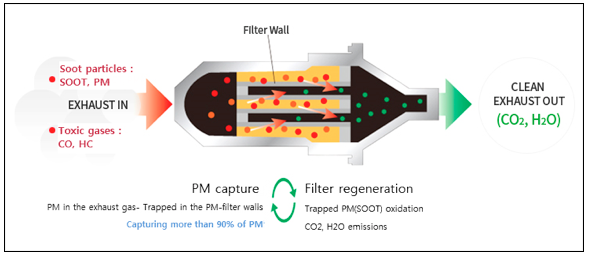
(Source: Korea Automobile Environmental Association, http://www.aea.or.kr/main_business/technology.php)
Figure 4. DPF regeneration method
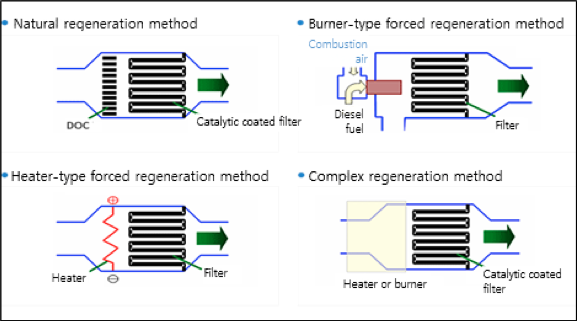
(Source: Korea Automobile Environmental Association, http://www.aea.or.kr/main_business/technology.php)
PMs are classified according to the heat supply system required for the combustion, as shown below.
Table 9. Heat supply system by generative method
| Type | Heat supply system | Applicable vehicles |
| Natural-regeneration | Engine exhaust heat | High-speed vehicles |
| Forced regeneration | Electric heater or auxiliary fuel injection | Low-speed vehicles |
| Complex regeneration | Mixed use of the natural- and force-regeneration methods | Low- and high-speed vehicles |
The exhaust gas is burned again by the oxidation catalyst located at the opening of the DPF, which decreases the size of the PM. These small PMs penetrate the filter and are released to the air, but other PMs that are still big are trapped in the filter and are accumulated on it through the repetitive process until the engine control system sprays the fuel to be burned in the DPF. This burning fuel increases the temperature in the DPF, and the heat burns the accumulated PMs again to make them smaller.
The process of spraying fuels to make the big PMs small is called “regeneration.” There are different ways of setting the timing of the regeneration. One is through the pressure differences between the front and back of the filter (pressure difference sensor). Every vehicle manufacturer has a different set point for the pressure difference. Some check the engine performance regularly based on its mileage to see how negatively the PMs affect the engine performance due to the filter clogging and the resulting increased pressure in the exhaust system. Once it detects a certain level of engine underperformance, it sprays fuel into the DPF. Other manufacturers use an extra equipment (scanner) to set the regeneration timing. The pressure difference sensor and mileage methods are applied differently according to the engine control system type, vehicle type, and DPF manufacturer.
The ways of increasing the temperature in the DPF to a point that is sufficient to burn the PMs accumulated on the filter are most important and vary. Some spray extra fuels into the PDF, some use additives, some use an electric heater, and others use an extra burner. Due to the cost issue, the most common method is spraying extra fuel into the DPF to increase the temperature to over the regeneration point while checking the temperature with an exhaust gas temperature sensor. Some manufacturers, however, are using additives for such purpose.
Although DPF reduces the PM emissions into the air, it increases the costs, decreases the fuel efficiency, and has short durability, which are the limitations of this emission reduction device. Many studies have pointed out that the average lifespan of the fuel-spraying DPF in terms of mileage is around 100,000 km.
2) Second-class emission control device (p-DPF: partial diesel particulate filter)
Rolled like a cylinder with a paired layer of flat foil and corrugated foil, p-DPF has a partially open structure. Therefore, the exhaust gas passes through the space between the flat foil and the corrugated foil. p-DPF does not reduce the engine power or fuel efficiency because it does not accumulate any PM on the filter, unlike the wall-flow-type filter. Moreover, it does not need periodic management of the filter because ashes do not stay thereon.
Figure 5. p-DPF structure

Figure 6. How p-DPF works?
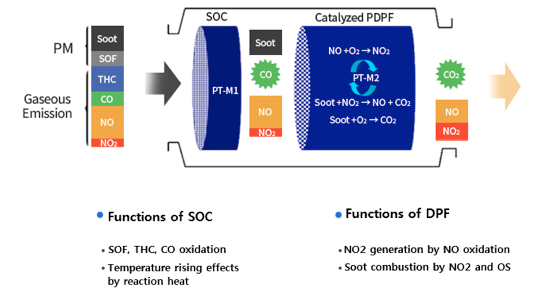
3) Third-class emission control device (DOC: diesel oxidation catalyst)
Figure 7. How DOC device controls emission
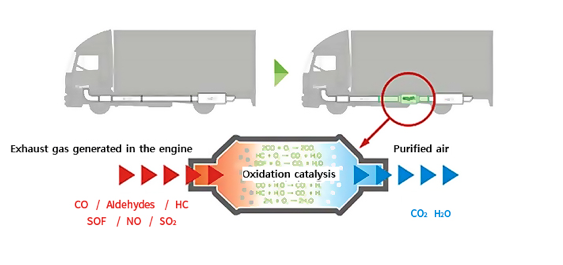
Figure 8. DOC structure
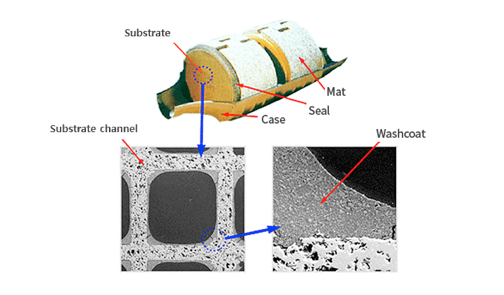
Policy Effects
Figure 9. Reduction of pollutants by emission control devices (2007-2009) (Unit: ton)
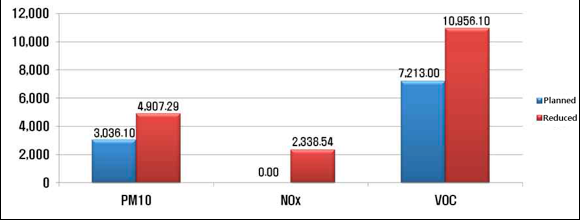
Source: Analysis of the air quality improvement effects of pollution control measures (2011)
To reduce the NOx in the air, the Seoul metropolitan government implemented the pilot project of attaching a NOx reduction device to 444 vehicles, like the attachment of a PM-NOx simultaneous-reduction device to old construction machinery and large trucks from 2013 to 2017, to verify the feasibility of such measure, and expanded the project implementation to beyond 2015.
Table 10. Average exhaust gas reduction ratio through the implementation of the NOx reduction pilot project
| Project title/exhaust gas | CO reduction | NOX reduction | PM reduction |
| Three-way catalytic converter | 82.2% | 88.4% | 60.1% |
| PM-NOX simultaneous-reduction device | 85% | 70% | 80% |
Challenges and Solutions
In this regard, the Seoul metropolitan government proceeded with the project of attaching PM-NOX simultaneous-reduction devices to 444 vehicles in 2013, including old construction machinery and large trucks, and since 2015, it has been expanding and promoting the project after the verification of its effects.